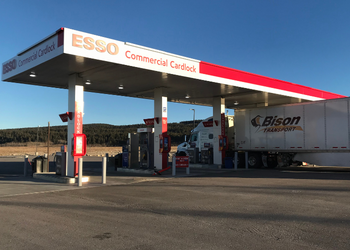AMTA is releasing a series of profiles of the people involved with the Cooperative Truck Platooning System (CTPS) project. The project is currently processing data from the nation’s first pair of artificially intelligent semi-trucks of their kind, including human factors.
Note: The following statements were prepared by the team at Esso Commercial Cardlocks.
AMTA: Why did Esso become involved with the CTPS system?
Esso: The Cooperative Truck Platooning System project connects with two key priorities for Imperial: safety and innovation.
From a safety perspective, everything we do at Imperial is based on our core value of ensuring that Nobody Gets Hurt. The project’s demonstration of platooning technology and its potential safety improvements for drivers and the motoring public is aligned with our commitment to helping protect the well-being of Canadians from every walk of life.
Secondly, we were interested in the project’s application of new technologies to the trucking industry – an important sector of the Canadian economy that Imperial is proud to help fuel through our network of over 160 Esso Commercial Cardlock™ locations across the country.
CTPS’s specific focus on increasing trucking fuel efficiency aligns with our own efforts to improve fuel economy through the application of innovative technologies. One example is our Synergy Diesel Efficient™ fuel that is pre-additized with an advanced patented formulation designed to clean up dirty deposits on diesel engine fuel injectors. In fact, Synergy Diesel Efficient™ provides a two percent fuel economy benefit while also helping to boost engine power and responsiveness, and reduce emissions (compared to diesel without a detergent additive).
AMTA: What is the importance of becoming involved with initiatives like CTPS?
Esso: Supporting initiatives like the platooning project speaks to Imperial’s wide-ranging commitment to the principles of environmental sustainability. As a company, we are committed to operating in an environmentally responsible manner in everything we do, and everywhere we do business. Our actions towards addressing the risks of climate change include providing fuel solutions for our customers to reduce their emissions, supporting research that leads to technology breakthroughs, reducing greenhouse gas intensity in our own operations, and participating in constructive dialogue on policy options to support the transition that is needed for a net-zero future.
For over 140 years, Imperial has been in the business of providing responsible energy solutions through changing times. Our participation in the CTPS project is an example of our continuing commitment to deliver affordable and reliable energy in a lower-carbon world.
AMTA: How did Esso come to be?
Esso: Imperial Oil, the company behind the Esso™ brand, was founded in 1880 in London, Ontario. Standard Oil of New Jersey (now Exxon Mobil Corporation) acquired a majority interest in Imperial in 1898, and during the 1900s, started marketing its products under the brand name ‘Esso’ (the phonetic pronunciation of the initials ‘S’ and ‘O’ in Standard Oil). Application for the Esso trademark was filed in 1923, and the Esso oval was introduced in the 1930s as a sign of quality and a symbol of service. Since then, the Esso name and oval have been used continuously in Canada and over 50 other countries.
Imperial’s connection with the province of Alberta was cemented with the company’s 1947 discovery of crude oil about 30 km south of Edmonton near Leduc, at that time a farming community with fewer than 900 residents. After having drilled 133 dry holes throughout the province in previous years, on Feb. 13 Imperial struck oil at Leduc No. 1, a well that went on to produce 317,000 barrels (50,400m3) of oil and 323 million cubic feet (9,100,000m3) of natural gas before being decommissioned in 1974. As a result of this discovery, massive immigration and billions of dollars of investment flowed into the province. One might say that Imperial played a founding role in the birth of Alberta’s energy industry.

